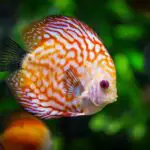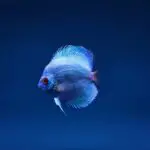The good news is that crappie still bites in cold weather, despite the chilly temperatures. In fact, they tend to bunch up during winter, so if you find their wintertime haunts you can fill your stringer and make the cold tolerable.
Of course, knowing where to look is key. Here are a few tips to help you locate winter crappie:
Look for deep water near structures, such as submerged brush piles or logs. Crappie will often congregate in these areas to stay out of the current and escape predators.
Another good option is to fish around docks or piers. The pilings provide cover for crappie and attract baitfish, making it a prime spot for feeding activities.
Finally, don’t forget about shallow flats adjacent to deep water. These areas can be productive when the sun warms them up during the day, drawing baitfish and crappie alike.
1. What is the ideal water temperature for crappie?
Crappie are a type of freshwater fish that are popular among anglers. They are relatively easy to catch and make for good eating. As such, they are often targeted by fishermen.
Knowing the ideal water temperature ranges and conditions for crappie activity can really amplify your success fishing for them. The best water temperature for crappie fishing is between 68 °F to 72 °F when the crappie spawn and post-spawn feed period seems to be at its highest point. This is the time when they are most active and thus more likely to be caught by anglers.
Crappie typically spawning in the springtime when water temperatures start to warm up. However, they will still bite during other times of the year if the conditions are right. For example, if there is an extended period of warm weather in the fall, crappie may continue to bite even though it is not technically spawning season anymore. It all depends on the specific body of water you are fishing in and what the temperature trends have been like lately.
There are a few things that you can do to increase your chances of catching crappie, even outside of their peak spawning season: use small lures or baitfish imitations; fish near cover such as docks, brush piles or logs; use light tackle so as not to spook them; and finally, be patient! Crappie can be finicky eaters so it may take some time before you get a bite even if you’re doing everything right.
2. Does cold weather affect a crappie’s biting behavior?
It’s a common question among anglers: does cold weather affect a crappie’s biting behavior? The answer, unfortunately, is not a simple one. While there are some general trends that can be observed, ultimately each fish is an individual and will react to the conditions in its own way.
That said, let’s take a look at some of the ways cold weather can impact a crappie’s biting behavior. One factor to consider is the water temperature. In general, crappies prefer water that is around 70 degrees Fahrenheit. When the water gets colder than that, they become less active and may stop biting altogether. This is because cold water slows down their metabolism, making them less interested in feeding.
Another factor to consider is the amount of light available. Crappies are generally more active during low-light periods (dawn and dusk), so you may have better luck catching them during those times if it’s cold outside. This is because they’re trying to conserve energy by staying in cooler areas and hiding from predators.
Finally, it’s worth noting thatCraps ike other fish become dormant during winter months when the water temperatures get very cold (below freezing). This isn’t necessarily due to the cold itself; rather, it’s an adaptive response to reduce their food intake since there are fewer food options available during this time of year. So don’t expect to catch many (if any) crappies during these months unless you’re fishing in waters that remain warm enough for them to stay active throughout winter (such as in Florida or Louisiana).
3. How deep do crappie usually swim in winter?
Crappie are a type of freshwater fish that are popular among anglers. They are typically found in shallow, murky waters and are known for their delicate flavor. In winter, crappie usually swim deeper than they do in other seasons. This is because the water is colder and the fish need to find warmer temperatures. The depths that crappie swim at vary depending on the body of water they are in and the temperature of the water. Some studies have shown that crappie generally prefer waters around 60 degrees Fahrenheit. However, they have been known to survive in waters as cold as 32 degrees Fahrenheit.
4. Are there certain times of day when crappie are more likely to bite in cold weather?
During the winter months, the best time for crappie fishing is early afternoon. This is when water temperatures are coolest and fish are more active. However, you may also have good luck early morning and late evening. Nighttime fishing can be productive, but it can be difficult to see your line and bait in the dark.
5. What type of bait do crappie prefer in winter?
Wintertime is a great time to go fishing for crappie. One of the best baits to use during this season is a shad- or minnow-shaped plastic grub with a long thin tail. These lures are ideal for casting to schools of winter crappie, whether in open water or around docks and brush piles. The reason why these work so well is because they resemble the types of baitfish that crappie feed on during the winter months.
6. Where do you typically find schooling Crappie in winter?
During the winter months, crappies tend to school up in deeper water. This is why it is important to put your fish finder to good use during this time of year. By doing so, you will be able to locate these fish more easily and increase your chances of success.
Another key tip for ice fishing for crappie is to take a buddy along with you on your trip. Not only will this provide an extra set of eyes and ears, but it can also help keep you safe while out on the ice. Be sure to practice all of the necessary safety measures when Ice Fishing, and you will be sure to have a successful and enjoyable experience.
7. How can you tell if a lake has good Crappie habitat?
If you’re wondering whether a lake has good Crappie habitat, there are a few things you can look for. First, try to find out what kind of vegetation is present in and around the lake. If there’s an abundance of aquatic plants, that’s usually a good sign. Another good indicator is the presence of submerged brush piles or other structures that provide shelter for the fish. In general, lakes with clear water and moderate amounts of vegetation tend to be the best places to look for Crappie.
Of course, it’s not always possible to tell just by looking at a lake whether it will be productive for Crappie fishing.
8. What are some tips for ice fishing for Crappies?
When it comes to ice fishing for crappies, there are a few key things you need to keep in mind in order to be successful. First and foremost, you need to make sure you have the right gear. This means having a quality ice auger, rod and reel, and appropriate clothing for the conditions.
Next, you’ll want to switch to a lighter line. In general, 4-6 pound test line is ideal for ice fishing. This will help prevent your line from breaking when dealing with the elements and also makes it easier to detect bites.
Crappies are most active at dusk, so that’s an ideal time to go fishing for them. You can also put your fish finder to good use during this time by targeting areas where there is likely to be high concentrations of fish.
To entice winter crappies into biting, try tipping your jigs with a live minnow. This added bit of realism can be just what they’re looking for in order to take the bait. Additionally, slow down your presentation as crappies tend to be more sluggish in cold water temperatures. Finally, don’t be afraid to experiment with different lures or baits until you find something that works well for you in these conditions.
9. What are some common mistakes people make when trying to catch Crappies in winter?
Crappies are a popular fish to catch in winter, but there are some common mistakes that people make when trying to catch them. One of the most common mistakes is not using the right bait. Crappies are attracted to bright colors and shiny objects, so using bait that is dull or dark in color will not work as well.
Another mistake is fishing in areas where there is no cover for the fish. Crappies like to hide under logs or rocks, so fishing in an open area will likely result in fewer bites.
Finally, many anglers use too much weight on their line, which makes it difficult for the crappie to take the bait. Using a lighter weight line will help increase your chances of success when fishing for crappies in winter.


